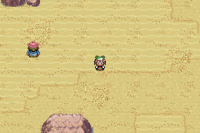Kanto Route 11
| |||
Connecting locations
| |||
| Location Kanto Route 0 Location of {{{name}}} in Kanto. |
Route 11 is an east-west route located in southeastern Kanto. Its western terminus is at Vermilion City and its eastern terminus is at the Silence Bridge, better known as Route 12. Just east of Vermilion, Route 11 meets the southern portal of Diglett's Cave, a major cave route connecting southeast Kanto with Pewter City and the remainder of western Kanto.
Route description
From its junction with Route 12, Route 11 passes over a short bridge before heading west through a clearing in the forest that lines the west side of Route 12. The route becomes more built-up as it approaches a lookout station, becoming fenced on each side. This station is seen by some as the eastern terminus of Route 11.
Inside of the station in Generation I and Generation III, trainers who have collected data on 30 or more Pokémon species in their Pokédex will be able to obtain the Itemfinder from one of Professor Oak's aides. Also, in Generation III, a trainer will trade a Nidorina or a Nidorino for the Pokémon of the opposite gender. The Pokémon requested varies by version. In Generation II, the lookout station has been torn down.
West of the station, the route is completely surrounded by grass patches. To avoid encounters with wild Pokémon, trainers can follow beaten dirt paths through the field. The first such path begins just west of the lookout station. The path turns south before resuming a westward alignment and turning north to intersect a short path that travels to the west. The main path continues north, then west to come to a near four-way intersection. The north and south paths ultimately lead to a dead end surrounded by grass while the west path continues toward Vermilion.
Several paces west of the four-way intersection is another three-way junction. The two routes, which isolate a small patch of grass from the rest of the route, rejoin east of Diglett's Cave. In Generation I and Generation III, the route runs along the north bank of a narrow channel as it meets the southern portal of Diglett's Cave and enters Vermilion. In Generation II, however, the junction that rejoins the two routes is located just east of the Vermilion City limits. The river is also non-existent and Diglett's Cave actually emerges in east Vermilion.
Items
Generation I
- Itemfinder: from Professor Oak's aide in the lookout station
Generation II
- Berry: from the berry tree in the northeast corner of the route
Generation III
- Awakening: in the northwest corner of the route
- Great Ball: directly south of the lookout station
- Itemfinder: from Professor Oak's aide in the lookout station
- X Defend: in a grass patch in the center of the route
Pokémon
Generation I
Grass
- Drowzee
- Ekans (Red)
- Pidgeotto (Yellow)
- Pidgey (Yellow)
- Raticate (Yellow)
- Rattata (Yellow)
- Sandshrew (Blue)
- Spearow (Red/Blue)
Fishing
Generation II
- Drowzee - All times (Gold/Silver); Night only (Crystal)
- Hoppip - Morning and Day (Crystal)
- Hypno - All times (Gold/Silver); Night only (Crystal)
- Magnemite - All times
- Meowth - Night only (Crystal)
- Pidgeotto - Morning and Day (Crystal)
- Raticate - All times (Crystal)
- Rattata - All times (Gold/Silver); Morning and Day (Crystal)
Generation III
Grass
- Drowzee
- Ekans (FireRed)
- Sandshrew (LeafGreen)
- Spearow
Fishing
- Gyarados - Super Rod
- Horsea - Good and Super Rods
- Krabby - Good and Super Rods
- Magikarp - Old and Good Rods
- Psyduck - Super Rod
- Slowpoke - Super Rod
Surfing
Differences Among Generations
Generations I and III
At the east end of Route 11 is a sleeping Snorlax, blocking not only Route 11 but also Route 12. To move it, a trainer must play the Poké Flute to awaken the Pokémon.
Generation II
In the most noticeable change, the number of trainers on the route had been slashed from ten to four. Just as noticeable is the removal of the lookout station on the east end of Route 11 and the moving of Diglett's Cave from Route 11 to Vermilion. Snorlax was also relocated from Route 12 to the entrance to Diglett's Cave. To move him, trainers had to use a PokéGear tuned to the Pokémon March to move the Pokémon, as the Poké Flute did not exist in Generation II.
See also
| Kanto | ||||||||
|---|---|---|---|---|---|---|---|---|
|
| ||||||||
|

|
This article is part of Project Routes, a Bulbapedia project that aims to write comprehensive articles on every route in the Pokémon world. |
